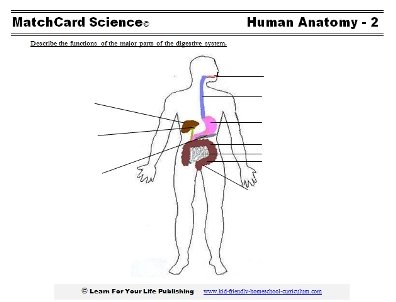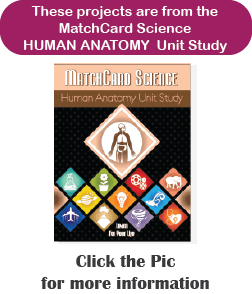Digestive System
Print the Human Digestion Worksheet
This lesson on the digestive system is from MatchCard Science Human Anatomy Unit Study.
Learn the major organs of human digestion and their functions.
Free Download Below
The Human Digestive System Worksheet
Print the Digestive System MatchCard
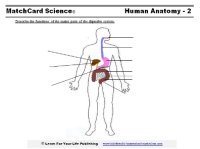

You can download a copy of the Digestive System MatchCard for use with your students. Click on the diagram to go to the download page for a printer ready copy.
Your student will place the information pieces on the correct location of the MatchCard. The information pieces can be found on the third page. Instructor's answer key is on the second page.
Getting Started: Let the digestive juices flow
Let's start this lesson by having students focus on sensations from their own digestive system.I like to start with a hot fudge sundae topped with nuts. Okay, maybe there is some personal preference here, but the goal is to "feel" the food going down the esophagus. The contrast of temperatures and textures in the sundae helps that to happen.
Ask the student to pay attention to the food after it is swallowed and tell you where they think it is going. What happens after it is swallowed?
With warm and cold foods, people can often feel the food in the esophagus. They might even note the sensation in their stomach.
Human Digestive System Activity for Kids
Lots of Mouth Action Before You Even Swallow!
Use the diagram on the Digestive System MatchCard to identify the route of food through the body.Mouth
The digestive system starts with the mouth. Have a variety of foods to chew and ask what is happening as they chew and swallow. Suggestions:- Something soft like yogurt, ice cream, cottage cheese
- Something cruncy like crackers, popcorn, nuts, pretzels
- Something with stringy fiber like celery or carrots that take lots of chewing
Crunchy Foods & Saliva - Note the effect of saliva in keeping food particles together. It is not like grinding a cracker with a rock.
Fiber Foods & Teeth - Notice the use of the teeth in grinding the food. Also notice that no matter how long you chew fiber, it stays somewhat "stringy." This fiber is important for digestion.
Esophagus
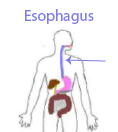
We usually are not aware of our esophagus. However, when swallowing warm or cold foods you may be aware of it moving down "your throat." That is one of the reasons soup and other foods "taste so good."
Any other experiences with your esophagus? Ask what it is like to get a potato chip "stuck in your throat."
Stomach

The stomach is a muscular bag the can get larger and smaller - like a balloon. It contains digestive acids which break solid food into smaller and softer particles. Ask what sensations can be felt by the stomach:
- Hunger - stomach "growling". The digestive juices have nothing to work on.
- Full - the stomach has expanded as far as it can with the food that has been eaten.
- Water logged - so much water has been consumed you can feel it sloshing in the stomach.
- Vomiting - The contents of the stomach are expelled up the esophagus and out the mouth. Yuck!
Ever notice a yucky taste after vomiting? That's the effect of the digestive acids. It is sure a whole lot nicer to keep all that stuff inside your stomach.
Small Intestine
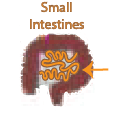
Inside the small intestine, digestive acids keep working to liquify food particles.
You can put some food into a blender and compare the action of the small intestines to the blender. The intestines don't have any sharp blades. But they do have a movement called peristalsis which mixes things up.
If you have ever squeezed a bag to mix the ingredients, you can compare that to peristalsis. You can also hear it with a stethescope on your own belly.
More than just blending is going on, however. The small intestines break large molecules of food into small molecules. Then the small molecules of nutrition are absorbed through the intestinal wall into the blood stream. That blood will go to the liver which will get those nutrients ready for the rest of the body.
However, most of the food product is not absorbed into the blood stream. It continues into the large intestines.
Large Intestine
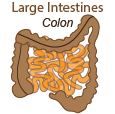
The large intestine starts in the lower right part of the abdomen. The appendix is located close to the place where the small intestines joins the large intestine. Severe pain in this area can sometimes mean a problem.
The large intestine moves food upward on the right hand side, across the abdomen at the top, and downward on the left side.
While the waste is in the large intestine, water is being absorbed from it.
When people have diarrhea, the waste moves so fast through the large intestine the water is not absorbed and instead is very liquid like. Diarrhea is also associated with cramping. The cramping is caused by very strong peristalsis waves.
Rectum and Anus
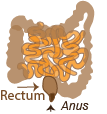
Three More Organs of the Human Digestive System
Older students in 5th to 8th grade should learn about three other digestive organs in their human anatomy unit study. These are labeled on the left side of the MatchCard.Liver
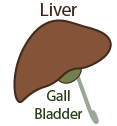
The liver has several important functions necessary for life.
First, it cleans the blood coming from the intestines of toxins and poisons. Cirrhosis of the liver is a disease that alcholics may get when the liver fails from the affect of the alcohol.
The liver also changes glucose, fats, and protein into forms of nutrition needed by the cells of the body. It can convert glucose into protein or fat. It can also change it back, depending on what the body needs.
The liver also produces a substance called bile. Bile is a green digestive juice that helps the small intestine break down fat.
In summary, the liver produces bile that goes into the small intestine and helps it break up fat particles. The nutrients in the small intestine go from the blood stream to the liver for it to change the nutrients into the chemical form needed by the cells of the body.
Gall Bladder

Bile is green and gives the green color associated with diarrhea. Sometimes people call it "vile bile."
The gall bladder is somewhat like the stomach: it is a sac that can get larger and smaller. It usually is about 7 cm and holds 30 to 50 ml of fluid. For comparison, fill a small plastic bag with that much water and see how large it is in comparison to your gall bladder.
Gall Stones
About 15% of people develop gallstones in their gallbladder. These may be smaller than a pebble or as large as a ping pong ball. If they float free inside the gallbladder they may not cause any problem. But if they end up blocking the duct to the gallbladder the person may develop severe pain and need to have their gallbladder removed.Pancrease

Insulin is a hormone produced by the pancrease that helps glucose move across a cell membrane from the blood stream into the cells of the body. Diabetics have a decrease in insulin so that the amount of glucose in their blood stays high.
Review of Digestion
There are two pathways for the ingredients in the food you eat to take through the body.Through the digestive tract
Food moves from the mouth, to the esophagus, stomach, small intestine, large intestine, rectum, and out through the rectum as waste.
Through the blood stream
Nutrients in the food are broken down in the stomach and small intestine. Then those nutrients are absorbed into the blood stream through the intestinal wall. They go a short distance in the blood stream to the liver.
The liver is an amazing chemistry lab that converts the nutrients into the molecular form needed by the cells to do their work. They travel from the liver to the parts of the body through the blood stream.
Fiber
Fiber is an important element of the diet that helps the digestive system function correctly. Unlike other forms of nutrition (vitamins, protein, glucose, etc.) fiber does not get absorbed into the blood stream. It stays in the first pathway and is excreted in the waste.A good example of fiber is celery. Remember the stringy stuff you chewed and chewed in the first part of the lesson? That is fiber.
Fiber pushes waste products through the intestines. It prevents constipation. Fiber also decreases a person's chance of getting cancer because synthetic chemicals and preservatives are removed from the body faster.
MatchCard Science
How To Use MatchCards

Download the FREE MatchCard Science Instructor's Guide and see how MatchCards can make building their science knowledge base fun.
Human Anatomy Unit Study
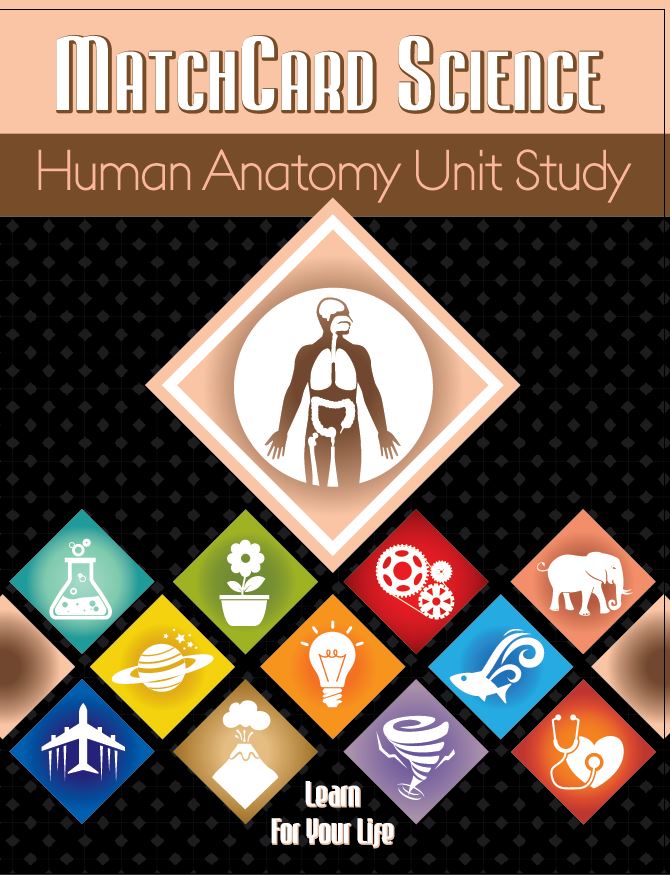
Download the entire Human Anatomy Unit Study
12 Science Unit Studies

Chemistry is only one of twelve complete unit studies for kids in 3rd to 8th grade.
Comprehensive objectives, hands-on projects, suggested science fair experiments, and the fun game-like MatchCards keep them interested in learning science. See all twelve MatchCard Science Unit Studies.
About Our Site
Hands-On Learning


